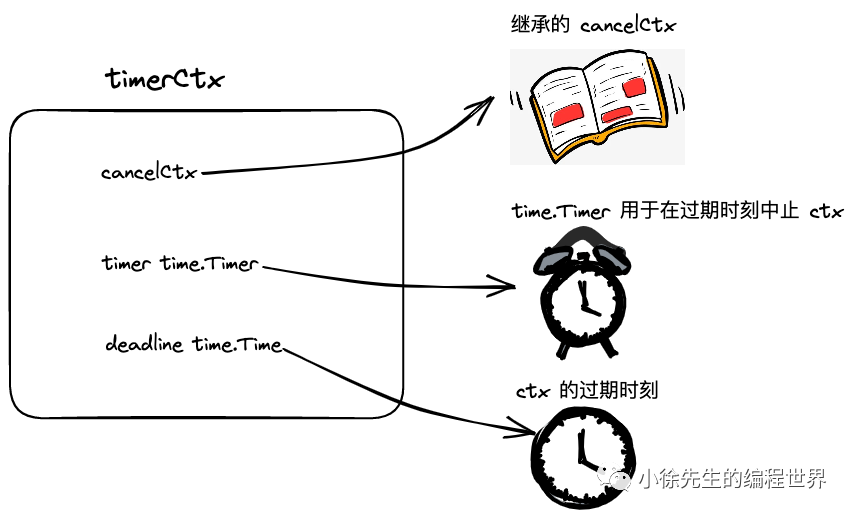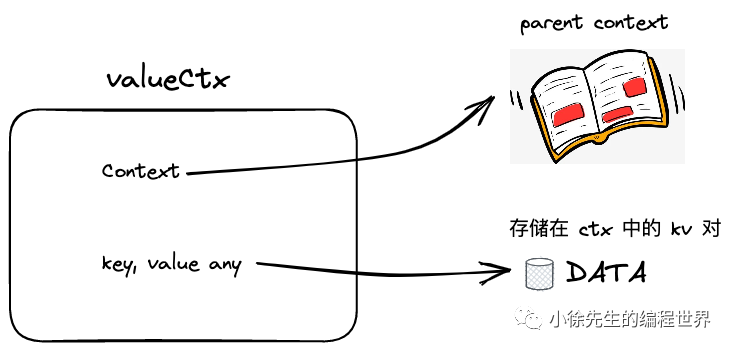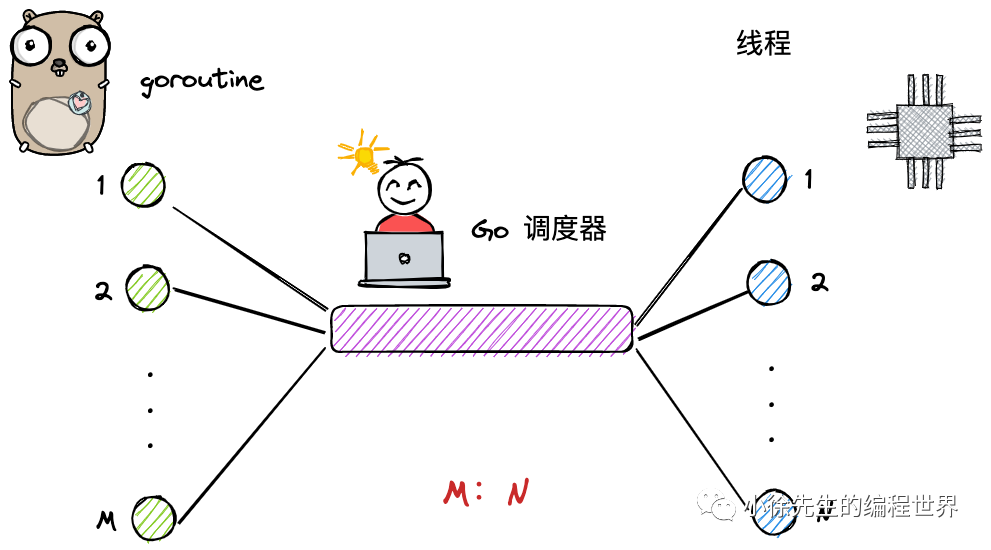参考
前言
context 是 golang 中的经典工具
- 主要在异步场景中用于实现并发协调以及对 goroutine 的生命周期控制.
- 除此之外,context 还兼有一定的数据存储能力.
- 本着知其然知其所以然的精神,本文和大家一起深入 context 源码一探究竟,较为细节地对其实现原理进行梳理.
为啥使用 Context
比如以下这个例子,一旦主协程关闭done channel,那么子协程就可以退出了,这样就实现了主协程通知子协程的需求
func main() {
// 数据通道
messages := make(chan int, 10)
// 信号通道
done := make(chan bool)
defer close(messages)
// consumer
go func() {
// 每隔一秒执行一次,定时器
ticker := time.NewTicker(1 * time.Second)
for _ = range ticker.C {
select {
// 若关闭了通道则 执行下面的代码
case <-done:
fmt.Println("child process interrupt...")
return
default:
fmt.Printf("send message: %d\n", <-messages)
}
}
}()
// producer
for i := 0; i < 10; i++ {
messages <- i
}
time.Sleep(5 * time.Second)
// 关闭通道, 退出上面的匿名函数
close(done)
time.Sleep(1 * time.Second)
fmt.Println("main process exit!")
}
假如主协程中有多个任务1, 2, …m,主协程对这些任务有超时控制。如果还是使用done channel的用法 ,那么使用done channel的方式将会变得非常繁琐且混乱
我们需要一种优雅的方案来实现这样一种机制:
- 上层任务取消后,所有的下层任务都会被取消;
- 中间某一层的任务取消后,只会将当前任务的下层任务取消,而不会影响上层的任务以及同级任务。
这个时候context就派上用场了
Context 的使用
注意: 这两种方式是创建根context,不具备任何功能,需要用到with系列函数来实现具体功能`
根 Context
- context.Backgroud()
- 是上下文的默认值,所有其他的上下文都应该从它衍生(Derived)出来, ,一般情况下我们用这个
- context.TODO()
- 应该只在不确定应该使用哪种上下文时使用;
With 系列函数
context.withCancel() 取消控制
就可以使用withCancel来衍生一个context传递到不同的goroutine中,当我想让这些goroutine停止运行,就可以调用cancel来进行取消
// 案例一
/*
代码逻辑:
我们使用withCancel创建一个基于Background的ctx,然后启动一个讲话程序,
每隔1s说一话,main函数在10s后执行cancel,那么speak检测到取消信号就会退出。
*/
package main
import (
"context"
"fmt"
"time"
)
// context.Background()函数创建根上下文,返回父context和cancel函数
func NewWithCancel() (context.Context, context.CancelFunc) {
return context.WithCancel(context.Background())
}
// 业务逻辑
func Speak(ctx context.Context) {
for range time.Tick(time.Second) {
select {
case <-ctx.Done():
fmt.Println("关闭线程...")
fmt.Println(ctx.Err())
default:
fmt.Println("hahahhaa")
}
}
}
func main() {
// 创建父context和cancel函数
ctx, cancel := NewWithCancel()
// 使用协程来启动业务逻辑
go Speak(ctx)
time.Sleep(10 * time.Second)
// 取消的信号,结束Speak函数的运行
cancel()
time.Sleep(1 * time.Second)
}
// 案例二
/*
代码逻辑:
1. 利用根Context创建一个父Context,使用父Context创建一个协程,
2. 利用上面的父Context再创建一个子Context,使用该子Context创建一个协程
3. 一段时间后,调用父Context的cancel函数,会发现父Context的协程和子Context的协程都收到了信号,被结束了
*/
package main
import (
"context"
"fmt"
"time"
)
func main() {
// 父context(利用根context得到)
ctx, cancel := context.WithCancel(context.Background())
// 父context的子协程
go watch1(ctx)
// 子context,注意:这里虽然也返回了cancel的函数对象,但是未使用
valueCtx, _ := context.WithCancel(ctx)
// 子context的子协程
go watch2(valueCtx)
fmt.Println("现在开始等待3秒,time=", time.Now().Unix())
time.Sleep(3 * time.Second)
// 调用cancel()
fmt.Println("等待3秒结束,调用cancel()函数")
cancel()
// 再等待5秒看输出,可以发现父context的子协程和子context的子协程都会被结束掉
time.Sleep(5 * time.Second)
fmt.Println("最终结束,time=", time.Now().Unix())
}
// 父context的协程
func watch1(ctx context.Context) {
for {
select {
case <-ctx.Done(): //取出值即说明是结束信号
fmt.Println("收到信号,父context的协程退出,time=", time.Now().Unix())
return
default:
fmt.Println("父context的协程监控中,time=", time.Now().Unix())
time.Sleep(1 * time.Second)
}
}
}
// 子context的协程
func watch2(ctx context.Context) {
for {
select {
case <-ctx.Done(): //取出值即说明是结束信号
fmt.Println("收到信号,子context的协程退出,time=", time.Now().Unix())
return
default:
fmt.Println("子context的协程监控中,time=", time.Now().Unix())
time.Sleep(1 * time.Second)
}
}
}
context.WithTimeout 超时控制
withTimeout或者withDeadline来做超时控制,当一次请求到达我们设置的超时时间,就会及时取消,不在往下执行。withTimeout和withDeadline作用是一样的,就是传递的时间参数不同而已,他们都会通过传入的时间来自动取消Context,这里要注意的是他们都会返回一个cancelFunc方法,通过调用这个方法可以达到提前进行取消
// 案例一
package main
import (
"context"
"fmt"
"time"
)
// 创建一个带超时context, 三秒后退出执行
func NewContextWithTimeout() (context.Context, context.CancelFunc) {
return context.WithTimeout(context.Background(), 3*time.Second)
}
// 处理程序
func HttpHandler() {
ctx, cancel := NewContextWithTimeout()
defer cancel()
deal(ctx)
}
// 业务逻辑代码
func deal(ctx context.Context) {
for i := 0; i < 10; i++ {
time.Sleep(1 * time.Second)
select {
case <-ctx.Done():
fmt.Println(ctx.Err())
return
default:
fmt.Printf("deal time is %d\n", i)
}
}
}
func main() {
HttpHandler()
}
// 案例二
package main
import (
"context"
"fmt"
"time"
)
func main() {
// 创建一个子节点的context,3秒后自动超时
ctx, cancel := context.WithTimeout(context.Background(), time.Second*3)
go watch(ctx, "监控1")
go watch(ctx, "监控2")
fmt.Println("现在开始等待8秒,time=", time.Now().Unix())
time.Sleep(8 * time.Second)
fmt.Println("等待8秒结束,准备调用cancel()函数,发现两个子协程已经结束了,time=", time.Now().Unix())
cancel()
}
// 单独的监控协程
func watch(ctx context.Context, name string) {
for {
select {
case <-ctx.Done():
fmt.Println(name, "收到信号,监控退出,time=", time.Now().Unix())
return
default:
fmt.Println(name, "goroutine监控中,time=", time.Now().Unix())
time.Sleep(1 * time.Second)
}
}
}
context.WithValue() 携带数据 [谨慎使用]
日常在业务开发中都希望能有一个trace_id能串联所有的日志,这就需要我们打印日志时能够获取到这个trace_id,在python中我们可以用gevent.local来传递,在java中我们可以用ThreadLocal来传递,在Go语言中我们就可以使用Context来传递,通过使用WithValue来创建一个携带trace_id的context,然后不断透传下去,打印日志时输出即可
/*
我们基于context.Background创建一个携带trace_id的ctx,然后通过context树一起传递,
从中派生的任何context都会获取此值,我们最后打印日志的时候就可以从ctx中取值输出到日志中。
目前一些RPC框架都是支持了Context,所以trace_id的向下传递就更方便了
*/
package main
import (
"context"
"fmt"
"strings"
"time"
"github.com/google/uuid"
)
type MyKEY string
const (
KEY MyKEY = "trace_id"
)
// 返回一个UUID
func NewRequestID1() MyKEY {
return MyKEY(strings.Replace(uuid.New().String(), "-", "", -1))
}
// 创建一个携带trace_id 的ctx
func NewContextWithTraceID() context.Context {
ctx := context.WithValue(context.Background(), KEY, NewRequestID1())
return ctx
}
// 打印值
func PrintLog(ctx context.Context, message string) {
fmt.Printf("%s|info|trace_id=%s|%s", time.Now().Format("2006-01-02 15:04:05"), GetContextValue1(ctx, KEY), message)
}
// 获取设置的key对应的值,并断言
func GetContextValue1(ctx context.Context, k MyKEY) MyKEY {
v, ok := ctx.Value(k).(MyKEY)
fmt.Println("打印k:" + k)
fmt.Printf("打印v: %v\n", v)
if !ok {
return ""
}
return v
}
func ProcessEnter(ctx context.Context) {
PrintLog(ctx, "Golang")
}
func main() {
ProcessEnter(NewContextWithTraceID())
}
- 不建议使用 context 值传递关键参数,关键参数应该显示的声明出来
- 因为携带value也是key value,避免context多个包使用带来的冲突,建议使用内置类型
- context 传递的数据 key value 都是 interface,所以类型断言时别忘了保证程序的健壮性
应用场景
-
RPC调用 -
PipeLine -
超时请求 -
`HTTP服务器的request互相传递数据
注意:
- 不要将 Context 塞到结构体里。直接将 Context 类型作为函数的第一参数,而且一般都命名为 ctx。
- 不要向函数传入一个 nil 的 context,如果你实在不知道传什么,标准库给你准备好了一个 context:todo。
- 不要把本应该作为函数参数的类型塞到 context 中,context 存储的应该是一些共同的数据。例如:登陆的 session、cookie 等。
- 同一个 context 可能会被传递到多个 goroutine,别担心,context 是并发安全的
核心数据结构
context.Context

context数据结构
type Context interface {
Deadline() (deadline time.Time, ok bool)
Done() <-chan struct{}
Err() error
Value(key any) any
}
Context 为 interface,定义了四个核心 api:
-
Deadline:返回 context 的过期时间;也就是完成工作的截止日期;如果没有设定期限,将返回ok == false
-
Done:返回 context 中的 channel;当绑定当前context的任务被取消时,将返回一个关闭的channel;如果当前context不会被取消,将返回nil
-
Err:返回错误;
- 如果 Done 返回的 channel 没有关闭,将返回 nil;如果 Done 返回的 channel 已经关闭,将返回非空的值表示任务结束的原因
- 如果是 context 被取消,Err 将返回 Canceled;如果是 context 超时,Err 将返回 DeadlineExceeded Err() error
-
Value:返回 context 中的对应 key 的值.
标准 error
var Canceled = errors.New("context canceled")
var DeadlineExceeded error = deadlineExceededError{}
type deadlineExceededError struct{}
func (deadlineExceededError) Error() string { return "context deadline exceeded" }
func (deadlineExceededError) Timeout() bool { return true }
func (deadlineExceededError) Temporary() bool { return true
-
• Canceled:context 被 cancel 时会报此错误;
-
• DeadlineExceeded:context 超时时会报此错误.
emptyCtx
类的实现
type emptyCtx int
func (*emptyCtx) Deadline() (deadline time.Time, ok bool) {
return
}
func (*emptyCtx) Done() <-chan struct{} {
return nil
}
func (*emptyCtx) Err() error {
return nil
}
func (*emptyCtx) Value(key any) any {
return
}
-
emptyCtx 是一个空的 context,本质上类型为一个整型;
-
Deadline 方法会返回一个公元元年时间以及 false 的 flag,标识当前 context 不存在过期时间;
-
Done 方法返回一个 nil 值,用户无论往 nil 中写入或者读取数据,均会陷入阻塞;
-
Err 方法返回的错误永远为 nil;
-
Value 方法返回的 value 同样永远为 nil.
context.Background() & context.TODO()
var (
background = new(emptyCtx)
todo = new(emptyCtx)
)
func Background() Context {
return background
}
func TODO() Context {
return todo
}
我们所常用的 context.Background() 和 context.TODO() 方法返回的均是 emptyCtx 类型的一个实例.
cancelCtx
cancelCtx 数据结构

cancelCtx数据结构
type cancelCtx struct {
Context
mu sync.Mutex // protects following fields
done atomic.Value // of chan struct{}, created lazily, closed by first cancel call
children map[canceler]struct{} // set to nil by the first cancel call
err error // set to non-nil by the first cancel call
}
type canceler interface {
cancel(removeFromParent bool, err error)
Done() <-chan struct{}
}
-
embed 了一个 context 作为其父 context. 可见,cancelCtx 必然为某个 context 的子 context;
-
Mu 内置了一把锁,用以协调并发场景下的资源获取;
-
done:实际类型为 chan struct{},即用以反映 cancelCtx 生命周期的通道;c.done 是“懒汉式”创建,只有调用了 Done() 方法的时候才会被创建。再次说明,函数返回的是一个只读的 channel,而且没有地方向这个 channel 里面写数据。所以,直接调用读这个 channel,协程会被 block 住。一般通过搭配 select 来使用。一旦关闭,就会立即读出零值。
-
children:一个 set,指向 cancelCtx 的所有子 context;
-
err:记录了当前 cancelCtx 的错误. 必然为某个 context 的子 context;
Deadline 方法
cancelCtx 未实现该方法,仅是 embed 了一个带有 Deadline 方法的 Context interface,因此倘若直接调用会报错.
Done 方法

cancelCtx.Done
.done 是“懒汉式”创建**,只有调用了 Done () 方法的时候才会被创建。再次说明,函数返回的是一个只读的 channel,而且没有地方向这个 channel 里面写数据。所以,直接调用读这个 channel,协程会被 block 住。一般通过搭配 select 来使用。
func (c *cancelCtx) Done() <-chan struct{} {
d := c.done.Load()
if d != nil {
return d.(chan struct{})
}
c.mu.Lock()
defer c.mu.Unlock()
d = c.done.Load()
if d == nil {
d = make(chan struct{})
c.done.Store(d)
}
return d.(chan struct{})
}
-
基于 atomic 包,读取 cancelCtx 中的 chan;倘若已存在,则直接返回;
-
加锁后,在此检查 chan 是否存在,若存在则返回;(double check)
-
初始化 chan 存储到 aotmic.Value 当中,并返回.(懒加载机制)
Err 方法
func (c *cancelCtx) Err() error {
c.mu.Lock()
err := c.err
c.mu.Unlock()
return err
}
-
• 加锁;
-
• 读取 cancelCtx.err;
-
• 解锁;
-
• 返回结果.
Value 方法
func (c *cancelCtx) Value(key any) any {
if key == &cancelCtxKey {
return c
}
return value(c.Context, key)
}
-
• 倘若 key 特定值 &cancelCtxKey,则返回 cancelCtx 自身的指针;
-
• 否则遵循 valueCtx 的思路取值返回
context.WithCancel()
context.WithCancel()
func WithCancel(parent Context) (ctx Context, cancel CancelFunc) {
if parent == nil {
panic("cannot create context from nil parent")
}
c := newCancelCtx(parent)
propagateCancel(parent, &c)
return &c, func() { c.cancel(true, Canceled) }
}
func newCancelCtx(parent Context) cancelCtx {
return cancelCtx{Context: parent}
}
-
• 校验父 context 非空;
-
• 注入父 context 构造好一个新的 cancelCtx;
-
• 在 propagateCancel 方法内启动一个守护协程,以保证父 context 终止时,该 cancelCtx 也会被终止;
-
• 将 cancelCtx 返回,连带返回一个用以终止该 cancelCtx 的闭包函数.
这是一个暴露给用户的方法,传入一个父 Context(这通常是一个 background,作为根节点),返回新建的 context,新 context 的 done channel 是新建的(前文讲过)。
当 WithCancel 函数返回的 CancelFunc 被调用或者是父节点的 done channel 被关闭(父节点的 CancelFunc 被调用),此 context(子节点) 的 done channel 也会被关闭。
注意传给 WithCancel 方法的参数,前者是 true,也就是说取消的时候,需要将自己从父节点里删除。第二个参数则是一个固定的取消错误类型:
propagateCancel

这个方法的作用就是向上寻找可以“挂靠”的“可取消”的 context,并且“挂靠”上去。这样,调用上层 cancel 方法的时候,由上层的协程来管理对子 context 的取消。如果没有父 context ,就自己新建一个携程
propagate流程
func propagateCancel(parent Context, child canceler) {
// 父节点是个空节点
if parent.Done() == nil {
return // parent is never canceled
}
// 找到可以取消的父 context
if p, ok := parentCancelCtx(parent); ok {
p.mu.Lock()
if p.err != nil {
// 父节点已经被取消了,本节点(子节点)也要取消
child.cancel(false, p.err)
} else {
// 父节点未取消
if p.children == nil {
p.children = make(map[canceler]struct{})
}
// "挂到"父节点上
p.children[child] = struct{}{}
}
p.mu.Unlock()
} else {
// 如果没有找到可取消的父 context。新启动一个协程监控父节点或子节点取消信号
go func() {
select {
case <-parent.Done():
child.cancel(false, parent.Err())
case <-child.Done():
}
}()
}
}
propagateCancel 方法顾名思义,用以传递父子 context 之间的 cancel 事件:
-
倘若 parent 是不会被 cancel 的类型(如 emptyCtx),则直接返回;
-
倘若 parent 已经被 cancel,则直接终止子 context,并以 parent 的 err 作为子 context 的 err;
-
假如 parent 是 cancelCtx 的类型,则加锁,并将子 context 添加到 parent 的 children map 当中;
-
假如 parent 不是 cancelCtx 类型,但又存在 cancel 的能力(比如用户自定义实现的 context),则启动一个协程,通过多路复用的方式监控 parent 状态,倘若其终止,则同时终止子 context,并透传 parent 的 err.
-
• 倘若 parent 的 channel 已关闭或者是不会被 cancel 的类型,则返回 false;
-
• 倘若以特定的 cancelCtxKey 从 parent 中取值,取得的 value 是 parent 本身,则返回 true. (基于 cancelCtxKey 为 key 取值时返回 cancelCtx 自身,是 cancelCtx 特有的协议).
cancelCtx.cancel

cancel() 方法的功能就是关闭 channel:c.done;递归地取消它的所有子节点;从父节点从删除自己。达到的效果是通过关闭 channel,将取消信号传递给了它的所有子节点。Goroutine 接收到取消信号的方式就是 select 语句中的 读 c.done 被选中
func (c *cancelCtx) cancel(removeFromParent bool, err error) {
// 必须要传 err
if err == nil {
panic("context: internal error: missing cancel error")
}
c.mu.Lock()
if c.err != nil {
c.mu.Unlock()
return // 已经被其他协程取消
}
// 给 err 字段赋值
c.err = err
// 关闭 channel,通知其他协程
if c.done == nil {
c.done = closedchan
} else {
close(c.done)
}
// 遍历它的所有子节点
for child := range c.children {
// 递归地取消所有子节点
child.cancel(false, err)
}
// 将子节点置空
c.children = nil
c.mu.Unlock()
if removeFromParent {
// 从父节点中移除自己
removeChild(c.Context, c)
}
}
-
• cancelCtx.cancel 方法有两个入参,第一个 removeFromParent 是一个 bool 值,表示当前 context 是否需要从父 context 的 children set 中删除;第二个 err 则是 cancel 后需要展示的错误;
-
• 进入方法主体,首先校验传入的 err 是否为空,若为空则 panic;
-
• 加锁;
-
• 校验 cancelCtx 自带的 err 是否已经非空,若非空说明已被 cancel,则解锁返回;
-
• 将传入的 err 赋给 cancelCtx.err;
-
• 处理 cancelCtx 的 channel,若 channel 此前未初始化,则直接注入一个 closedChan,否则关闭该 channel;
-
• 遍历当前 cancelCtx 的 children set,依次将 children context 都进行 cancel;
-
• 解锁.
-
• 根据传入的 removeFromParent flag 判断是否需要手动把 cancelCtx 从 parent 的 children set 中移除.
走进 removeChild 方法中,观察如何将 cancelCtx 从 parent 的 children set 中移除:
func removeChild(parent Context, child canceler) {
p, ok := parentCancelCtx(parent)
if !ok {
return
}
p.mu.Lock()
if p.children != nil {
delete(p.children, child)
}
p.mu.Unlock()
}
-
• 如果 parent 不是 cancelCtx,直接返回(因为只有 cancelCtx 才有 children set)
-
• 加锁;
-
• 从 parent 的 children set 中删除对应 child
-
• 解锁返回.
timerCtx
类

timerCtx数据结构
type timerCtx struct {
cancelCtx
timer *time.Timer // Under cancelCtx.mu.
deadline time.Time
}
timerCtx 在 cancelCtx 基础上又做了一层封装,除了继承 cancelCtx 的能力之外,新增了一个 time.Timer 用于定时终止 context;另外新增了一个 deadline 字段用于字段 timerCtx 的过期时间.
timerCtx.Deadline()
func (c *timerCtx) Deadline() (deadline time.Time, ok bool) {
return c.deadline, true
}
context.Context interface 下的 Deadline api 仅在 timerCtx 中有效,由于展示其过期时间.
timerCtx.cancel
func (c *timerCtx) cancel(removeFromParent bool, err error) {
c.cancelCtx.cancel(false, err)
if removeFromParent {
removeChild(c.cancelCtx.Context, c)
}
c.mu.Lock()
if c.timer != nil {
c.timer.Stop()
c.timer = nil
}
c.mu.Unlock()
}
-
• 复用继承的 cancelCtx 的 cancel 能力,进行 cancel 处理;
-
• 判断是否需要手动从 parent 的 children set 中移除,若是则进行处理
-
• 加锁;
-
• 停止 time.Timer
-
• 解锁返回.
context.WithTimeout & context.WithDeadline
func WithTimeout(parent Context, timeout time.Duration) (Context, CancelFunc) {
return WithDeadline(parent, time.Now().Add(timeout))
}
context.WithTimeout 方法用于构造一个 timerCtx,本质上会调用 context.WithDeadline 方法:
func WithDeadline(parent Context, d time.Time) (Context, CancelFunc) {
if parent == nil {
panic("cannot create context from nil parent")
}
if cur, ok := parent.Deadline(); ok && cur.Before(d) {
// The current deadline is already sooner than the new one.
return WithCancel(parent)
}
c := &timerCtx{
cancelCtx: newCancelCtx(parent),
deadline: d,
}
propagateCancel(parent, c)
dur := time.Until(d)
if dur <= 0 {
c.cancel(true, DeadlineExceeded) // deadline has already passed
return c, func() { c.cancel(false, Canceled) }
}
c.mu.Lock()
defer c.mu.Unlock()
if c.err == nil {
c.timer = time.AfterFunc(dur, func() {
c.cancel(true, DeadlineExceeded)
})
}
return c, func() { c.cancel(true, Canceled) }
}
-
• 校验 parent context 非空;
-
• 校验 parent 的过期时间是否早于自己,若是,则构造一个 cancelCtx 返回即可;
-
• 构造出一个新的 timerCtx;
-
• 启动守护方法,同步 parent 的 cancel 事件到子 context;
-
• 判断过期时间是否已到,若是,直接 cancel timerCtx,并返回 DeadlineExceeded 的错误;
-
• 加锁;
-
• 启动 time.Timer,设定一个延时时间,即达到过期时间后会终止该 timerCtx,并返回 DeadlineExceeded 的错误;
-
• 解锁;
-
• 返回 timerCtx,已经一个封装了 cancel 逻辑的闭包 cancel 函数.
valueCtx
类

valueCtx数据结构
type valueCtx struct {
Context
key, val any
}
-
• valueCtx 同样继承了一个 parent context;
-
• 一个 valueCtx 中仅有一组 kv 对.
valueCtx.Value()

valueCtx.Value
func (c *valueCtx) Value(key any) any {
if c.key == key {
return c.val
}
return value(c.Context, key)
}
-
• 假如当前 valueCtx 的 key 等于用户传入的 key,则直接返回其 value;
-
• 假如不等,则从 parent context 中依次向上寻找.
func value(c Context, key any) any {
for {
switch ctx := c.(type) {
case *valueCtx:
if key == ctx.key {
return ctx.val
}
c = ctx.Context
case *cancelCtx:
if key == &cancelCtxKey {
return c
}
c = ctx.Context
case *timerCtx:
if key == &cancelCtxKey {
return &ctx.cancelCtx
}
c = ctx.Context
case *emptyCtx:
return nil
default:
return c.Value(key)
}
}
}
-
• 启动一个 for 循环,由下而上,由子及父,依次对 key 进行匹配;
-
• 其中 cancelCtx、timerCtx、emptyCtx 类型会有特殊的处理方式;
-
• 找到匹配的 key,则将该组 value 进行返回.
valueCtx 用法小结
阅读源码可以看出,valueCtx 不适合视为存储介质,存放大量的 kv 数据,原因有三:
-
• 一个 valueCtx 实例只能存一个 kv 对,因此 n 个 kv 对会嵌套 n 个 valueCtx,造成空间浪费;
-
• 基于 k 寻找 v 的过程是线性的,时间复杂度 O(N);
-
• 不支持基于 k 的去重,相同 k 可能重复存在,并基于起点的不同,返回不同的 v. 由此得知,valueContext 的定位类似于请求头,只适合存放少量作用域较大的全局 meta 数据.
context.WithValue()
func WithValue(parent Context, key, val any) Context {
if parent == nil {
panic("cannot create context from nil parent")
}
if key == nil {
panic("nil key")
}
if !reflectlite.TypeOf(key).Comparable() {
panic("key is not comparable")
}
return &valueCtx{parent, key, val}
}
-
• 倘若 parent context 为空,panic;
-
• 倘若 key 为空 panic;
-
• 倘若 key 的类型不可比较,panic;
-
• 包括 parent context 以及 kv 对,返回一个新的 valueCtx.
通过层层传递 Context ,最终形成这样一棵树:

和链表有点像,只是它的方向相反:Context 指向它的父节点,链表则指向下一个节点。通过 WithValue 函数,可以创建层层的 valueCtx,存储 goroutine 间可以共享的变量。
取值的过程,实际上是一个递归查找的过程:
func (c *valueCtx) Value(key interface{}) interface{} {
if c.key == key {
return c.val
}
return c.Context.Value(key)
}它会顺着链路一直往上找,比较当前节点的 key 是否是要找的 key,如果是,则直接返回 value。否则,一直顺着 context 往前,最终找到根节点(一般是 emptyCtx),直接返回一个 nil。所以用 Value 方法的时候要判断结果是否为 nil。